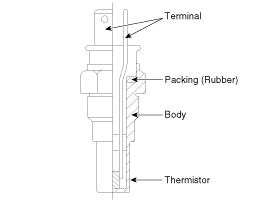Kia Cadenza: Engine Control System / CVVT Oil Temperature Sensor (OTS) Description and Operation
Kia Cadenza YG 2016-2025 Service Manual / Engine Control / Fuel System / Engine Control System / CVVT Oil Temperature Sensor (OTS) Description and Operation
| Description |
Continuous Variable Valve Timing (CVVT) system advances or
retards the valve timing of the intake and exhaust valve in accordance
with the ECM control signal which is calculated by the engine speed and
load.
By controlling CVVT, the valve over-lap or under-lap occurs,
which makes better fuel economy and reduces exhaust gases (NOx, HC) and
improves engine performance through reduction of pumping loss, internal
EGR effect, improvement of combustion stability, improvement of
volumetric efficiency, and increase of expansion work.
This system consist of
- the CVVT Oil Control Valve (OCV) which supplies the engine
oil to the cam phaser or cuts the engine oil from the cam phaser in
accordance with the ECM PWM (Pulse With Modulation) control signal,
- the CVVT Oil Temperature Sensor (OTS) which measures the engine oil temperature,
- and the Cam Phaser which varies the cam phase by using the hydraulic force of the engine oil.
The engine oil getting out of the CVVT oil control valve
varies the cam phase in the direction (Intake Advance/Exhaust Retard) or
opposite direction (Intake Retard/Exhaust Advance) of the engine
rotation by rotating the rotor connected with the camshaft inside the
cam phaser.

 Rail Pressure Sensor (RPS) Repair procedures
Rail Pressure Sensor (RPS) Repair procedures
Inspection
1.
Connect the GDS on the Data Link Connector (DLC).
2.
Measure the output voltage of the RPS at idle and various engine speed.
ConditionOutput Voltage (V)Idle Approx. 1.21, ...
 CVVT Oil Temperature Sensor (OTS) Specifications
CVVT Oil Temperature Sensor (OTS) Specifications
Specification
TemperatureResistance (kΩ)°C°F-40-4052.15-20-416.520326.020682.45401041.11601400.54801760.29
...
Other information:
Kia Cadenza YG 2016-2025 Service Manual: Cluster ionizer Repair procedures
Inspection 1. Press the OFF switch more then 4 times within 2 seconds while pressing the MODE switch. DisplayFail description00Normal50Cluster ionizer fault * Diagnostic procedure refer to DTC code. Replacement 1. Disconnect the negative (-) battery terminal. 2. Remove the crash ...
Kia Cadenza YG 2016-2025 Service Manual: Yaw-rate and G Sensor Description and Operation
Description When the vehicle is turning with respect to a vertical axis the yaw rate sensor detects the yaw rate electroniclly by the vibration change of plate fork inside the yaw rate sensor. If yaw velocity reaches the specific velocity after it detects the vehicle''yawing, the ESP control ...
Copyright © www.kcadenzavg.com 2017-2025

